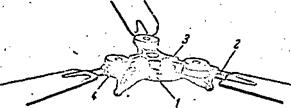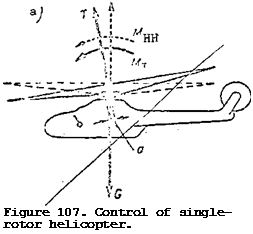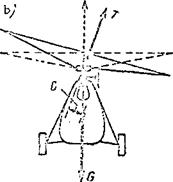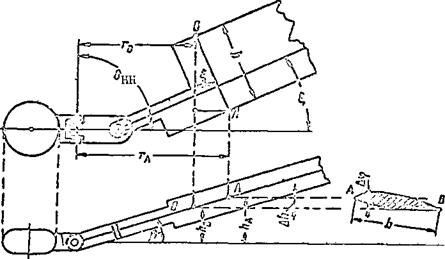§ 4. General Characteristics
The main rotor (MR) is a basic component of a helicopter. It is utilized to create the lift and motive force and to control the helicopter.
The basic parts of the main rotor are the hub and the blades.
The blades create the thrust force that is necessary for flight. The hub connects all the blades and serves to fasten the main rotor to the drive shaft. The drive shaft causes the rotor to rotate.
It is possible to subdivide main rotors into three types depending on the structural arrangement:
Those with rigidly fastened blades;
Those with fully articulated blades;
Those with a semi-rigid (flapping) arrangement.
A main rotor with rigidly fastened blades (Figure 6) has the simplest construction and this is its main advantage. But this rotor has inherent and serious disadvantages, which will be discussed in Chapter IV. Therefore, this type of rotor is not utilized in contemporary helicopters. At present, on some light helicopters, as for example the American helicopters, Hughes UH-6A,
Hiller EH-1100 and others, main rotors with spring fastened blades are used. /J-.Q. These rotors can be considered as a variety of rotor with rigid blades.
 |
|
by definite geometric parameters: file shape, blade incidence angle, and the solidity coefficient.
|
|
|
The diameter of the rotor is the diameter of the circle swept out by the blade tips. It is designated by the letter D and the radius R. The radius of a blade element is designated r (Figure 8a). The ratio of the radius of a blade element to the radius of the rotor is termed the relative radius
|
|


which gives r = rR
The blade planform shape can be rectangular, trapezoidal or a combination (Figure 8b).
In form, the blade resembles the wing of an airplane. The forward edge of the blade is called the leading edge, and the aft edge is called the trailing edge.
Trapezoidal blades have the most uniform distribution of aerodynamic /11
forces along the blade. Rectangular blades are simpler to manufacture, but they have several poor aerodynamic characteristics. The most widely used blades are trapezoidal and rectangular in combination.


 The profile of the blade is the term used for the form of the blade section perpendicular to the longitudinal axis. The profile of a blade resembles the profile of a wing.
The profile of the blade is the term used for the form of the blade section perpendicular to the longitudinal axis. The profile of a blade resembles the profile of a wing.
Most often double convex asymmetrical sections are used (Figure 8c).
The requirements for a blade profile are:
High aerodynamic efficiency,
Small shift of center of pressure with changes in angle of attack;
The ability to autorotate over a considerable range of angles of attack.
The profile of the blade is characterized by the relative thickness о = c/b and the relative camber f = f/Ъ (Figure 9).
 -p.__ n j According to the relative thick-
-p.__ n j According to the relative thick-
Figure 9. Blade profile parameters. °
ness, the profile is classified as
thin (c < 8%), medium (c = 8 – 12%), or thick (c > 12%). Most blades have
a relative thickness of c > 12%. The use of thick profiles allows an increase in the force resistance of an element and the stiffness of the blade.
In addition, the aerodynamic efficiency depends less on the angle of attack for thick profiles. This peculiarity of the profile improves the blade properties in the autorotation regime. Generally, the outermost element of the blade has a greater thickness ratio than at the root.
A relative camber of the blade of f = 2 – 3% brings the profile form /12
closer to symmetry, which leads to a decrease in the shift of the center of pressure with changes of angle of attack.
The incidence angle of the blade element is termed the angle ф; it is formed by the angle between the element chord and the plane of rotation of the main rotor hub (Figure 10) . The incidence angle is often called the pitch of the blade element. This is an arbitrary definition. In a more strict definition the pitch of the blade element is the distance H. This distance is obtained from the distance a blade element travels parallel to the chord after one revolution of the main rotor
H = 2ттг tan ф
Owing to the fact that the pitch of a blade element depends only on the incidence angle ф, then in the subsequent discussion we will identify the concept "incidence angle" with the concept "blade element pitch". At different elements of the blade the incidence angles will be different.
The pitch of the blade is taken as the incidence angle, or the pitch of the blade element, with a relative radius of r = 0.7. This angle is defined as the incidence angle (pitch) of the main rotor.
 As the blade turns relative to the longitudinal axis, the incidence angle changes. Such turning is possible thanks to the presence of the axial hinge. Consequently, the axial hinge of the main rotor blade is intended for pitch alteration.
As the blade turns relative to the longitudinal axis, the incidence angle changes. Such turning is possible thanks to the presence of the axial hinge. Consequently, the axial hinge of the main rotor blade is intended for pitch alteration.
The alteration of the pitch of the blade elements over the radius of the main rotor is termed the geometric twist of the blade.
At the root of the blade elements, the incidence angles are the largest, while at the tip they are the smallest (Figure 11). Geometric twist improves the operating conditions of the blade elements, and the angles of attack approach the optimum. This causes an increase of the thrust force of the lifting rotor of 5 – 7%. Therefore, geometric twist increases the useful loading of the helicopter at constant engine power.
Owing to geometric twist a more uniform force loading on the blade element is achieved and the speed, at which flow breakdown occurs on the retreating blade, is increased. The majority of blades have a geometric twist which does not exceed 5-7°
Stiffness is understood to mean the ability of the blade to retain its /13 form. With great stiffness, even force loading is not capable of deforming the structure and external shape of the blade. With small stiffness the blade becomes flexible and easily yields to deformation, that is, the blade is strongly bent and twisted. If the flexibility is too great, the optimum
&ч>



 6. 4 – 2 • О –
6. 4 – 2 • О –
-г –
twist cannot be maintained on the blade. This leads to inferior aerodynamic characteristics of the main rotor.
In order to obtain great stiffness, it is necessary to increase the size of the load supporting elements, which leads to increased weight of the blade. Unnecessarily high stiffness leads to an increase of vibration of the main rotor.
The greatest stiffness is obtained with blades of metal or of continuous wooden construction, but the latter are very heavy and are utilized only on light helicopters.
The area swept out by the main rotor is the area of the circle described by the blade tips
This characteristic of the main rotor has approximately the same importance as the wing area of a fixed wing airplane, that is, it is similar to the lifting surface area.
The disk loading, based on the swept area, is defined as the ratio of helicopter weight to area, that is, the area swept out by the main rotor.
 G_ F •
G_ F •
2
where, P = specific loading, kgf/m ;
G = helicopter weight, kgf;
„ 2 F = swept area, m.
Contemporary helicopters have specific loadings that vary from 12 to 25 kgf. m2 (or 120 – 150 N/m2).
The solidity coefficient is equal to the ratio of the total planfrom area of all the blades to the area swept out by the main rotor.
 SBk
SBk
F
where, = planform area of one blade, m ;
D
к = number of blades
Contemporary main rotors have perhaps from 2 to 6 blades. Most often there are 3-4 blades on light helicopters and 5-6 blades on heavy helicopters. The space factor has a value from.04 to.07. This means that 4 – 7% of the area swept out by the rotor is taken up by the blades. The larger the space factor, within the limits indicated, the larger the thrust developed by the rotor. But if the space factor exceeds.07, then the forces of resistance to rotation are increased and the blade efficiency of the main rotor is decreased.


















 The profile of the blade is the term used for the form of the blade section perpendicular to the longitudinal axis. The profile of a blade resembles the profile of a wing.
The profile of the blade is the term used for the form of the blade section perpendicular to the longitudinal axis. The profile of a blade resembles the profile of a wing. -p.__ n j According to the relative thick-
-p.__ n j According to the relative thick- As the blade turns relative to the longitudinal axis, the incidence angle changes. Such turning is possible thanks to the presence of the axial hinge. Consequently, the axial hinge of the main rotor blade is intended for pitch alteration.
As the blade turns relative to the longitudinal axis, the incidence angle changes. Such turning is possible thanks to the presence of the axial hinge. Consequently, the axial hinge of the main rotor blade is intended for pitch alteration.




 We have assumed that the entire area swept by the rotor participates in creating thrust. This means that the increased air pressure below the rotor and the reduced air pressure above the rotor (Figure 25a) acts on the entire main rotor area. In reality, as will be shown later, the entire swept area does not participate in creating thrust. The ideal rotor accelerates a uniform air jet downward with the same induced velocity for all the blade elements. The real rotor provides a swirling jet, and the induced velocities will vary markedly along the radius for the different blade elements (Figure 25b).
We have assumed that the entire area swept by the rotor participates in creating thrust. This means that the increased air pressure below the rotor and the reduced air pressure above the rotor (Figure 25a) acts on the entire main rotor area. In reality, as will be shown later, the entire swept area does not participate in creating thrust. The ideal rotor accelerates a uniform air jet downward with the same induced velocity for all the blade elements. The real rotor provides a swirling jet, and the induced velocities will vary markedly along the radius for the different blade elements (Figure 25b).